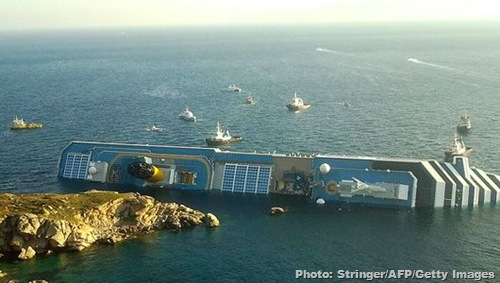
Mysteries of the deep (and not so deep): Here are a few famous vessels and the circumstances that did them in, from wartime to disgraced captains.
Grab a pack of Dramamine and brush up on your muster drill skills, folks…we’re expecting a rough passage ahead.
Over the centuries shipwrecks have managed to captivate and confound historians, scientists, adventurers and the disaster-tracking public like no other maritime event. How do they happen? In many cases, that answer isn’t always crystal clear with possible clues lying hundreds of feet on the ocean floor. And what can we learn from history’s most ill-fated vessels? How can improvements in safety legislation and advances in nautical technology and engineering help to prevent these tragic, terrifying and often heavily romanticized disasters?
In a quest to learn more, we’ve rounded up a diverse sampling of notorious shipwrecks that occurred during peacetime and wartime. These disasters, while not necessarily the most deadly or dramatic in history, are each significant in their own way. Each is the result of varying circumstances: treacherous weather, military conflict, collisions with other vessels or objects, truly terrible captains and on. Many - specifically those that have foundered - are the subject of on-going deep-sea forensic expeditions and artefact recovery efforts. As a result, these ghostly wrecks are treated as archaeological sites and are subject to extensive diving restrictions.
Our list is presented in chronological order. And while it might seem that the number of casualties associated with each shipwreck decreases as time marches on, let’s not forget that modern-day maritime disasters such as the sinking of the MV Doña Paz and the MS Estonia claimed hundreds, even thousands of lives.
Following our main entries, we’ve included 10 more shipwrecks of note. Is there a famous shipwreck that particularly intrigues you?
1. RMS Titanic
Port of registry: Liverpool, England.
Maiden voyage: April 10, 1912.
Sink date: April 15, 1912 following an iceberg strike about 375 miles south of Newfoundland.
Casualties: 1,517
Not really much of an explanation - or a soundtrack - needed for this one. Icebergs, lifeboat shortages, Molly Brown, the most dedicated cruise boat orchestra in the history of the world.
We all know what happened just before midnight on April 14, 1912, as the reputedly unsinkable RMS Titanic proceeded along its maiden voyage from Southampton to New York City. Instead, let’s consider the revelations that have been made since the wreck of the 882-foot luxury liner was discovered 12,000 feet below the ocean’s surface in September 1985.
One of the more recent - and controversial - discoveries was revealed a day after the 100th anniversary of the ship’s sinking when the National Oceanic and Atmospheric Administration (NOAA) released a photograph of a boot and what’s believed to be a coat found on a seabed. According to NOAA officials, the underwater imagery provides “compelling evidence” that human remains can be found in the sediment of a massive debris field. “I as an archaeologist would say those are human remains. Buried in that sediment are very likely forensic remains of that person,” NOAA director of maritime heritage James Delgado told the Associated Press. “These are not shoes that fell out neatly from somebody's bag right next to each other.”
Officials hope that the discovery of the articles will help the site earn official graveyard status, which would protect it from salvagers. Official Titanic obsessor James Cameron, who has visited the wreck more than 30 times, and other experienced divers aren’t convinced. Cameron tells the New York Times: “We’ve seen clothing. We’ve seen shoes. We’ve seen pairs of shoes, which would strongly suggest there was a body there at one point. But we’ve never seen any human remains.” Adds maritime lawyer and diver David G. Concannon: “It’s a legal tactic. The opponents of salvage want to equate it to a grave site.”
2. RMS Lusitania
Port of registry: Liverpool, United Kingdom.
Maiden voyage: September 1907
Sink date: May 7, 1915, after being torpedoed by a German U-boat 11 miles off the coast of Ireland.
Casualties: 1,198
Often overshadowed by the tragic foundering of the Titanic only four years later, the technologically advanced, sumptuously outfitted RMS Lusitania met a fate that was just as harrowing: While en route to Liverpool from New York on May 7, 1915, the super-luxe Cunard liner was torpedoed by the German submarine U-20 11 miles off the Old Head of Kinsale, County Cork. Following the attack, the 787-foot vessel plunged 300 feet to the bottom of the Irish Sea within 18 minutes. The ship was carrying both civilians and a massive amount of contraband munitions in its cargo - a controversial factor that birthed an international blame game and a fair amount of conspiracy theories. The attack gave the stunned 1,959 passengers and crew little time to evacuate and escape in lifeboats (yes, there were enough). In comparison, the Titanic sank in a little less than three hours.
Only 761 people survived the attack on the Lusitania. Although not as many high society names appeared on the ship's manifest when compared to the Titanic, a good number of socialites, business tycoons, politicians, writers and at least one Vanderbilt perished. Most succumbed to hypothermia. Prior to departing from New York, the German embassy had warned passengers of the dangers of traveling through submarine-infested waters during wartime (check out the right side of this Washington Times front page for the warning). Most did not heed the warnings. In the end, 128 defiant Americans lost their lives.
The most notable aspect of the Lusitania wasn’t the sinking itself or any subsequent wreckage expeditions by Robert Ballard or others. Rather, it was the impact the event had on the course of world history. Following the attack, many staunchly neutral countries opted to side against Germany in World War I. What’s more, the sinking of the Lusitania served as one of the primary catalysts for President Woodrow Wilson’s decision to formally enter the United States into the conflict two years later. The event played a crucial role in American recruitment efforts with images of the doomed ship and its passengers appearing in several propaganda posters, including this rather tragic one.
3. German Battleship Bismarck
Commissioned: August 1940
Sink date: May 27, 1941, after engaging in a heavy naval battle with British forces in the North Atlantic off the coast of France.
Casualties: Over 2,000
Sink. Sank. Very sunk. The demise of the uber-armoured German Battleship Bismarck, itself a very accomplished ship sinker, was the result of a rather hairy altercation in the North Atlantic with a fleet of Royal Navy battleships and heavy cruisers including the HMS Rodney, King George V, Norfolk and Dorsetshire. Only 115 of the ship’s 2,220-man crew survived the battle. Proclaimed British Navy Admiral John Tovey after the Bismarck - the most feared and also the most admired vessel of its kind - sank deep into the ocean: “The Bismarck had put up a most gallant fight against impossible odds worthy of the old days of the Imperial German Navy, and she went down with her colours flying.”
It wasn’t until 1989 that the remarkably well-preserved wreck of the Bismarck was located 15,000 feet deep by none other than the same famed deep-sea explorer who had discovered the final resting place of the Titanic four years prior: Oceanographer Robert Ballard. During that expedition Ballard was able to lay to rest years of speculation about how the mighty Bismarck sank. His conclusion? The Bismarck had not been sunk by the British, rather the ship had been scuttled - deliberately sunk - by its own crew. The 2002 James Cameron-directed (go figure) Discovery Channel documentary “Expedition: Bismarck” came to a similar conclusion after an extensive survey. It’s believed that the ship could have stayed afloat for several more hours if its crew had not sabotaged the engine room valves, hastening its foundering.
And what about the HMS Hood, the iconic British battle cruiser that the Bismarck destroyed just days earlier in the Battle of the Denmark Strait? The remains were discovered during a 2001 expedition led by American shipwreck hunter David Means (he also explored the Bismarck earlier that year) of Blue Water Recoveries. In September 2012, Means returned to the wreck in a Paul Allen-backed expedition to retrieve one of the ship’s two bells. That mission, sponsored by the HMS Hood Association and the National Museum of the Royal Navy, was postponed due to bad weather. (The photo above shows the HMS Rodney firing on the Bismarck.)
4. American Battleship USS Arizona
Commissioned: October 1916
Sink date: Dec. 7, 1941, after being bombed by Japanese aircraft during the attack on Pearl Harbour.
Casualties: 1,177
Unless your name happens to be James Cameron (or Robert Ballard), most of the wrecks featured on this list aren’t exactly easy to access. An exception is the vulnerable USS Arizona, the built-in-Brooklyn American battleship that exploded and sank during the attack on the Pearl Harbour Naval Base in Oahu, Hawaii. Straddling the submerged hull of the vessel is the USS Arizona Memorial, an accessible-by-boat site operated by the National Park Service that’s visited by upwards of 1 million visitors a year. The wreck itself has been designated as a National Historic Landmark while the Alfred Preis-designed memorial, dedicated in 1962, is listed on the National Register of Historic Places.
The Arizona’s superstructure, armament and any other elements that rose above the waterline were removed not long after the catastrophic surprise attack - “a date which will live in infamy” - on Pearl Harbour by the Imperial Japanese Army. However, one of the ship’s barbettes rises above the surface of the water and is clearly visible to visitors.
And then there’s the issue of the hull…although submerged it is still leaking oil - the so-called “Tears of the Arizona” - 71 years later at the rate of about 2 to 9 quarts per day. Since 1998 the National Park Service Submerged Resource Centre and the USS Arizona Memorial have been closely monitoring the environmentally precarious situation. Explains the USS Arizona Memorial website: “Although observed rates of oil coming to the surface has gradually increased over the past several years, there is no indication of increase in amount of oil released from the primary oil containment spaces in the ship’s lower decks. The increase in oil release rates vary considerably with differing wind, tide and harbour conditions. Although the exact amount cannot be determined, the USS Arizona contains an estimated 500,000 gallons (litres) of Bunker-C fuel within its hull.”
During the attack on Pearl Harbour, seven additional battleships were sunk or damaged along with multiple other vessels and aircraft. In total, 2,042 Americans were killed at Pearl Harbour, nearly half of them aboard the USS Arizona.
5. SS Andrea Doria
Port of registry: Genoa, Italy.
Maiden voyage: June 1953
Sink date: July 26, 1956, following a collision with a smaller Swedish luxury liner, the MS Stockholm, off the coast of Nantucket, Massachusetts, USA.
Casualties: 46
Although it may now be firmly ingrained in our collective memory as a “Seinfeld” plot device (“It eased into the water like an old man into a nice warm bath”), the capsizing and subsequent sinking of New York-bound Italian passenger ship SS Andrea Doria following a collision with a 13,000-ton vessel in heavy fog off the coast of Nantucket was a massive event during its time and remains one of the largest - and most famous - maritime disasters to occur in American waters. The 2012 sinking of another ill-fated Italian cruise boat, the Costa Concordia, no doubt stirred up memories of the incident for Andrea Doria survivors, including author Pierette Domenica Simpson. She told the New York Times: “If you put the two photographs together of the night scene of the Concordia and the night scene of the Andrea Doria with the incline on the starboard side and the lights coming from the portholes, you cannot tell the difference.”
The listing luxury liner, described by CBS News correspondent Douglas Edwards as “looking like a colourful but big and dead hippopotamus,” claimed relatively few lives following a broadside ramming by the MS Stockholm. A swift evacuation and successful rescue operation are to credit for this (a big departure from the Costa Concordia) with a majority of casualties occurring during the collision itself and not during the ship’s capsizing and sinking. However, a number of scuba diving treasure hunters have perished over the years while exploring or trying to reach the deteriorating wreckage of the 700-foot Andrea Doria, a super-treacherous site that’s known within the wreck-diving community as the “Mount Everest of Scuba Diving.” (The photo above shows the Andrea Doria sinking after being struck by the Stockholm in 1956, with half of the ship's lifeboats still on-board as a result of the boat's severe list after the collision.)
6. SS Edmund Fitzgerald
Port of registry: United States
Maiden voyage: September 1958
Sink date: Nov. 10, 1975, after encountering a severe winter storm on Lake Superior.
Casualties: 29
The same episode of “Seinfeld” that found always tactful George battling over an available apartment with a survivor of the Andrea Doria also managed to sneak in a reference to the largest ship to ever sink in the Great Lakes, a 729-foot freighter named the Edmund Fitzgerald. And, of course, there’s Canadian crooner Gordon Lightfoot’s melancholy take on the fateful night in 1975 that the “Mighty Fitz” foundered in the middle of Lake Superior while en route to Detroit. “That good ship and crew was a bone to be chewed. When the gales of November came early.” Seriously, between Lightfoot and Céline Dion, Canadians have a knack at releasing chart-topping ballads about shipwrecks.
To this day, it’s a mystery why exactly the Edmund Fitzgerald, an iconic Great Lakes “workhorse” that spent nearly 20 years hauling iron ore between Superior, Wis., to various ports, sank without so much as a distress signal during a fierce winter storm that had rolled over Lake Superior. The 70 mph sustained winds and 35-foot waves obviously had something to do with it, but in terms of causal factors, it is unclear if rogue waves, flooding in the cargo hold, shoaling or structural failure ultimately did the boat in. Additional theories exist as well.
Numerous diving expeditions have been launched over the years to learn more about the demise of the Edmund Fitzgerald - the wreck is located at a depth of 530 feet near the entrance to Whitefish Bay - including ones directed by Fred Shannon and Jean-Michel Cousteau. In 1995, Canadian explorer Joseph B. MacInnis led a successful bell recovery mission at the request of the families of the freighter’s missing crew. Currently, the wreck is protected as a marine archaeological site and dives are highly restricted. Following extensive search efforts, the bodies of all 29 members of the ship’s crew were never recovered. The insurance executive whom the ship was named after passed away in 1986 at the age of 90.
7. Costa Concordia
Port of registry: Genoa, Italy.
Maiden voyage: July 2006
Sink date: Jan. 13, 2012, after striking a reef and running aground at Isola del Giglio, Tuscany.
Casualties: 32
It’s traumatic enough when you’re aboard a luxury cruise liner that strikes a reef, loses power and begins to list before drifting and running aground. But how about when your (apparently) cocaine-sniffing captain delays evacuations and then abandons ship while there are still 300 stunned and panicked passengers aboard and refuses to return to his sinking vessel?
On the evening of Jan. 13, 2012, just that happened off the western coast of Italy at Isola del Giglio. In an ordeal described by the New York Times as a “drama that seemed to blend tragedy with elements of farce” and that’s often compared to a modern-day Titanic disaster due to its botched evacuation, a 952-foot cruise boat from hell, the Costa Concordia, struck a reef and partly capsized in the Tyrrhenian Sea. At the time, 4,252 people were on board. Thirty-two of them, both crew and passengers, perished and scores of others suffered injuries. The disgraced captain in question, Francesco Schettino, was arrested and faces charges of manslaughter, causing a shipwreck, and abandoning ship. As for that last one, Schettino claimed that he slipped and fell overboard off of a deck and into a lifeboat while helping passengers evacuate the ship. Mmm hmm.
Following the wreck and rescue efforts, the partially submerged Costa Concordia was successfully defueled, eliminating growing fears of an environmental catastrophe. The salvage mission, described as the largest refloat in history, is in progress. It’s expected to be completed by the summer of 2013.
10 more famous founderings:
1545: The Mary Rose (British warship)
1852: HMS Birkenhead (British troopship)
1865: SS Republic (American steamship)
1865: SS Sultana (American steamship)
1898: USS Maine (American battleship)
1916: HMHS Britannic (British ocean liner)
1945: MV Wilhelm Gustloff (German ocean liner)
1987: MV Doña Paz (Philippine passenger ferry)
1994: MS Estonia (Estonian cruise ferry)
2002: MV Le Joola (Senegalese passenger ferry)
Related shipwreck stories on Mother Nature Network:
Top image: The Costa Concordia struck a reef in the Tyrrhenian Sea in January 2012. Its disgraced captain faces charges of manslaughter, causing a shipwreck and abandoning ship.
Related Posts:
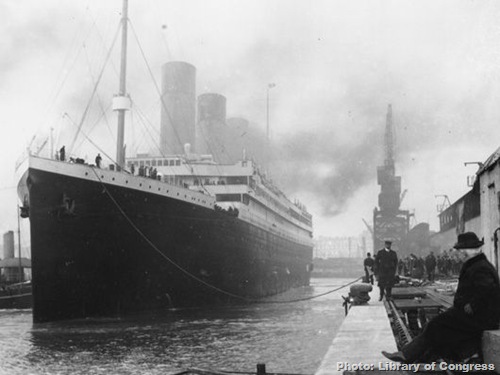
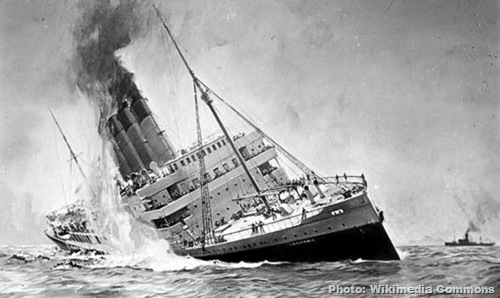


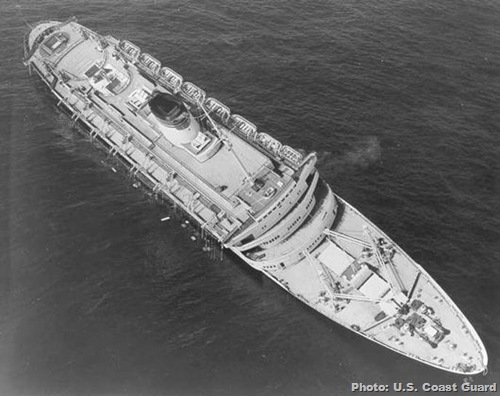

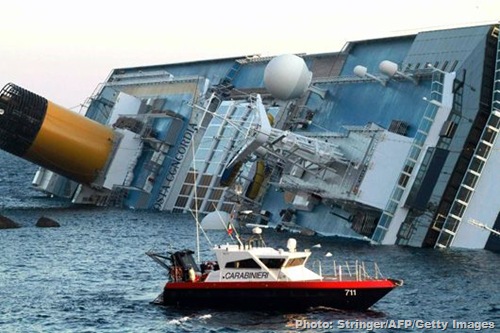
No comments:
Post a Comment
Please adhere to proper blog etiquette when posting your comments. This blog owner will exercise his absolution discretion in allowing or rejecting any comments that are deemed seditious, defamatory, libelous, racist, vulgar, insulting, and other remarks that exhibit similar characteristics. If you insist on using anonymous comments, please write your name or other IDs at the end of your message.